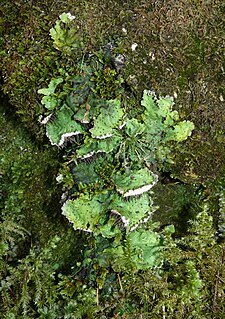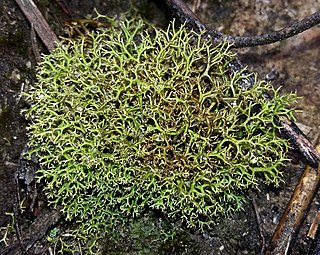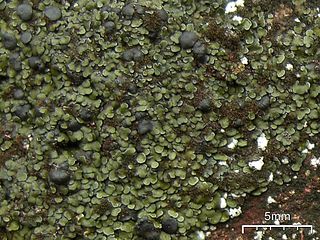
Peltigera is a genus of approximately 100 species of foliose lichens in the family Peltigeraceae. Commonly known as the dog lichens, species of Peltigera are often terricolous, but can also occur on moss, trees, rocks, and many other substrates in many parts of the world.
Scutula is a genus of lichenicolous fungi in the family Ramalinaceae.

The Arthoniaceae are a family of lichenized, lichenicolous and saprobic fungi in the order Arthoniales. The Arthoniaceae is the largest family of Arthoniales, with around 800 species. Most species in Arthoniaceae belong in Arthonia which is the largest genus with 500 species. The second and third largest genus is Arthothelium with 80 species, and Cryptothecia with 60 species.

The Pannariaceae are a family of lichens in the order Peltigerales. Species from this family have a widespread distribution, but are especially prevalent in southern temperate regions.

The Mycocaliciaceae are a family of seven genera and about 90 species of fungi in the order Mycocaliciales.

Cladia is a genus of lichenized fungi in the family Cladoniaceae. Cladia species have a crustose primary thallus and a fruticose, secondary thallus, often referred to as pseudopodetium. The type species of the genus, Cladia aggregata, is widely distributed, occurring from South America, South Africa, Australasia and South-East Asia to southern Japan and India. Most of the other species are found in the Southern Hemisphere.

Pannaria is a genus of lichen-forming fungi in the family Pannariaceae. The widespread genus contains an estimated 51 species, found primarily in tropical regions.

Amandinea is a genus of lichenized fungi in the family Caliciaceae. Genetic studies indicates that the genus Amandinea and Buellia are the same, although this is not widely accepted.

Stigmatochroma is a genus of lichenized fungi in the family Caliciaceae. The genus has a widespread distribution, and contains 9 species.

Lecanographa is a genus of about 40 species of lichens in the family Lecanographaceae. It was circumscribed in 1994 by José M. Egea and Pilar Torrente, with Lecanographa lyncea as the type species.

Melanelia is a genus of lichenized fungi in the family Parmeliaceae. The genus was circumscribed by Ted Esslinger in 1978.

Parmelina is a genus of lichen belonging to the family Parmeliaceae. The genus was circumscribed in 1974 by American lichenologist Mason Hale with Parmelina tiliacea assigned as the type species.

Lecidella is a genus of crustose lichens in the family Lecanoraceae.

Chaenothecopsis is a genus of about 40 species of pin lichens in the family Mycocaliciaceae. Many of the species are resinicolous, meaning they grow on conifer resin or other plant exudates. Most common host plants are trees in the genera Abies, Picea, and Tsuga.

Spilonema is a genus of lichen-forming fungi in the family Coccocarpiaceae. It has 4 species.
Dictyonema is a genus of mainly tropical basidiolichens in the family Hygrophoraceae.

Protoparmelia is a genus of lichenized fungi in the family Parmeliaceae. The genus has a widespread distribution, and contains 11 species. Protoparmelia was circumscribed by French lichenologist Maurice Choisy in 1929.

Trapeliaceae is a family of lichens in the order Baeomycetales. The family contains 12 genera and about 125 species.
Orcularia is a genus of four species of lichens in the family Caliciaceae. It was originally circumscribed as a section of the genus Rinodina by Swedish botanist Gustaf Oskar Andersson Malme in 1902. Klaus Kalb and Mireia Giralt promoted it to generic status in 2011. Orcularia is characterized by the presence of ascospores that develop in such a way that the septum is inserted after lateral wall thickenings become distinct, and also by threadlike (filiform) conidia.
Chrismofulvea is a genus of lichen-forming fungi in the family Caliciaceae. The genus was circumscribed by Austrian lichenologist Bernhard Marbach in 2000, with Chrismofulvea dialyta assigned as the type species. It was one of several segregate genera proposed by Marbach in his 2000 revision of American species of Buellia.















